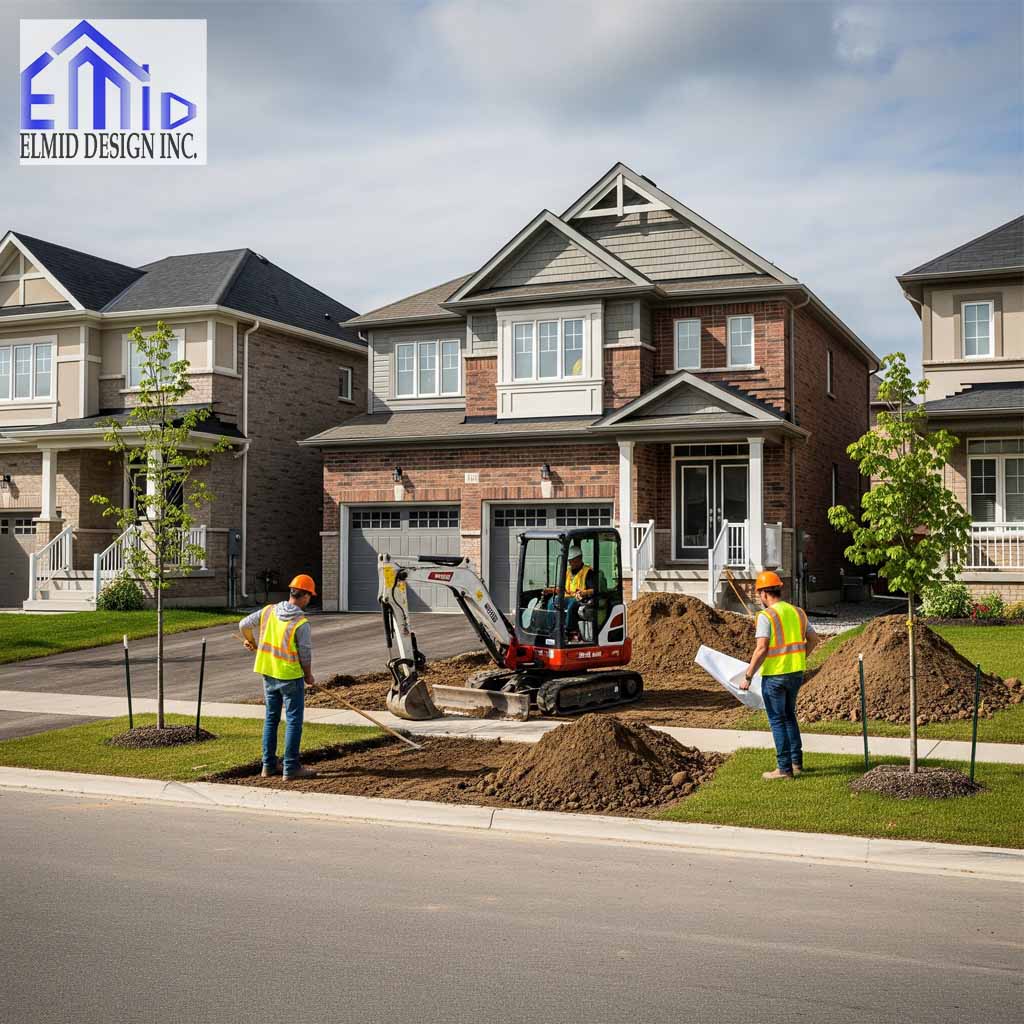A grading plan Hamilton is an essential requirement for any development or building project in the city. It defines how the land will be shaped to manage surface water drainage, protect structures, and meet all municipal standards before construction begins. The City of Hamilton requires detailed grading plans to approve permits for residential, commercial, or infill projects. Without one, building approvals stall, timelines stretch, and costly revisions often follow. This article explains what a grading plan is, how Hamilton enforces compliance, why it matters for property owners and developers, and how certified firms like Elmid Design Inc provide expertise to ensure approval and long-term safety.
What Is a Grading Plan in Hamilton?
A grading plan is a technical drawing that shows both existing and proposed ground elevations on a property. In Hamilton, this plan ensures that water drains away from buildings and into approved municipal systems. The drawing includes swales, spot elevations, driveway slopes, and finished foundation grades. The City relies on these details to confirm safe drainage for each lot and to protect neighboring properties from runoff issues. The plan also defines how stormwater will move across the site and whether retention or infiltration features are needed. By designing with both function and regulation in mind, a grading plan creates the foundation for a safe and stable project.
Hamilton’s Regulatory Requirements
Hamilton has strict requirements for grading plans, outlined by its Planning and Development Engineering departments. Developers must follow the Lot Grading Owner’s Undertaking, which sets minimum design standards for slopes, drainage swales, and foundation heights. These requirements mirror the Ontario Building Code but also apply Hamilton-specific adjustments. For example, driveways must maintain minimum slopes for proper water runoff, while foundation elevations must rise at least 150 millimeters above finished grade. Any non-compliance results in permit delays or outright rejection. The city also requires that a licensed professional engineer prepare or review all grading plans, ensuring accuracy and accountability. This regulatory framework protects homeowners, municipalities, and developers from long-term risks tied to poor site drainage.
Common Components of a Hamilton Grading Plan
A Hamilton grading plan contains multiple elements that must appear clearly on the drawing. Each plan includes a benchmark tied to a known elevation, proposed and existing ground levels, and directional arrows showing drainage flow. Swales are marked with slope percentages, while driveways are labeled to show grade transitions. Spot elevations identify critical points around foundations, patios, and landscaped areas. The City of Hamilton also expects grading plans to use standard labeling conventions that separate existing grades from proposed ones. Proper legends, north arrows, and property boundary markings are also required. These components together form a technical map that guides both approval and on-site execution, ensuring that the final construction aligns with city expectations and property safety.
Why Compliance Matters in Hamilton
Compliance with Hamilton’s grading standards is more than just a formality. Poor drainage can damage foundations, erode landscaping, and push water into neighboring lots, creating disputes and legal liability. Municipal inspectors hold developers responsible for these risks, and a rejected grading plan halts building permits. Without compliance, property values can also decrease due to long-term maintenance and flooding issues. Meeting city standards protects homeowners, strengthens resale value, and ensures sustainable development practices. For developers, following Hamilton’s grading requirements avoids re-design costs, shortens approval timelines, and minimizes on-site construction corrections. Compliance with grading standards demonstrates responsibility, professionalism, and long-term thinking in every project.
How Elmid Design Inc Supports Hamilton Projects
Elmid Design Inc, a licensed engineering firm with a Certificate of Authorization from Professional Engineers Ontario, provides specialized services for grading plan Hamilton projects. Their team understands the city’s unique regulations and ensures that every plan meets the latest municipal standards. They combine technical expertise with modern tools like CAD and GIS mapping to produce accurate, permit-ready designs. Elmid Design Inc also coordinates directly with Hamilton’s municipal staff to speed up approvals and minimize costly revisions. Their reputation for precision and compliance makes them a trusted partner for both residential and commercial developments. With their guidance, developers gain confidence in meeting requirements, protecting investments, and achieving smooth project delivery.
Key Takeaways
Grading plan Hamilton is the foundation of successful site development. It ensures proper drainage, compliance with municipal standards, and protection of both properties and communities. Hamilton requires precise details on swales, slopes, and foundation elevations, with oversight by licensed engineers. Non-compliance leads to delays and costs, while proper execution ensures safety and value. Elmid Design Inc plays a central role in guiding developers through the process, ensuring accuracy, compliance, and efficiency at every step. For anyone pursuing construction in Hamilton, a proper grading plan is not just a requirement but a safeguard for long-term success.

Challenges in Hamilton Grading Plan Projects
Developers in Hamilton often face unique challenges when preparing grading plans. Older neighborhoods with established infrastructure create difficulties when introducing new drainage patterns. Infill developments may struggle with limited space for swales or stormwater controls, especially when adjacent lots are already tightly built. Soil conditions also present complications, as clay-heavy ground reduces water absorption and requires more complex solutions. Seasonal factors such as frost and thaw cycles add another layer of difficulty, making precise slope design essential. Municipal reviewers frequently return plans for revisions when any of these issues are overlooked. To avoid delays, engineers must anticipate these challenges and provide detailed, accurate solutions that meet both provincial codes and Hamilton-specific standards.
Case Study: Grading for a Hamilton Residential Development
A residential subdivision in Hamilton recently demonstrated the importance of detailed grading plans. The site included uneven terrain and proximity to municipal storm sewers. The engineering team prepared a grading plan that balanced swales and adjusted driveway slopes to direct runoff safely. When the City reviewed the plan, minor revisions were requested to improve stormwater flow and reduce potential erosion at the lot boundaries. After quick modifications, approval was granted, and construction began without delay. This project highlighted how foresight, precision, and collaboration with municipal staff accelerate approvals. Firms such as Elmid Design Inc bring both experience and technical expertise to these situations, ensuring grading plans align with city requirements and prevent long-term drainage issues.
Best Practices for Hamilton Developers
Successful grading plan preparation in Hamilton requires careful attention to detail. Developers should start with accurate topographic surveys that reflect existing elevations. Proposed slopes must direct water away from foundations while also guiding it toward approved drainage systems. Foundation heights need to remain at least 150 millimeters above finished grade to avoid water infiltration. Engineers should also confirm that swales maintain consistent slope percentages and connect smoothly to municipal infrastructure. Collaboration with city reviewers ensures that concerns are addressed quickly, avoiding repeated submissions. By applying these best practices, developers reduce risks, control costs, and secure faster approvals. Partnering with licensed professionals such as Elmid Design Inc ensures each step follows Hamilton’s strict guidelines and meets industry standards for safety and reliability.
Post-Construction Validation and Lot Grading Certificate
Hamilton requires that grading work on-site matches the approved plan before occupancy permits are released. Inspectors visit the property to verify slopes, swale locations, and finished foundation grades. If discrepancies exist, developers must correct them promptly. A Lot Grading Certificate may be issued once the site meets the required standards. This certificate confirms compliance and assures the city that the property has proper drainage. Without it, occupancy cannot proceed, leading to costly delays. Engineers often support this stage by providing as-built surveys and adjusting designs if field conditions differ from the original plan. Elmid Design Inc offers post-construction validation services that help developers complete projects on schedule while satisfying municipal inspectors.
Stormwater Management in Hamilton Grading Plans
Stormwater management has become a core part of grading plans in Hamilton. The city requires that surface water from each property flows safely to approved outlets without overloading municipal systems. Engineers must design retention or infiltration features when runoff exceeds capacity. For larger developments, underground storage tanks, rain gardens, or controlled outlets are often added to balance flows. These solutions help protect nearby properties and reduce flooding risks. By integrating stormwater systems into grading plans, engineers provide both compliance and long-term sustainability. Elmid Design Inc includes stormwater modeling as part of their design process, ensuring every Hamilton project meets municipal standards while protecting the environment from excess runoff.
Zoning Impacts on Grading Plan Hamilton Projects
Zoning by-laws in Hamilton directly affect grading plans by defining setbacks, building coverage, and allowable elevations. Residential zones often require specific drainage setbacks between houses, while commercial lots demand larger stormwater provisions. Failing to consider zoning early can lead to rejected submissions, even if the technical grading is sound. For example, infill developments in older neighborhoods face strict rules to ensure that new drainage patterns do not harm adjacent properties. Each zoning category imposes different grading expectations, which must align with both the Ontario Building Code and local regulations. Elmid Design Inc ensures zoning analysis is completed at the start of every Hamilton project to avoid costly redesigns and delays during permit review.
How Grading Influences Landscaping and Property Value
Grading affects far more than just drainage in Hamilton. Proper grading allows homeowners to create functional and attractive outdoor spaces that enhance property value. A level surface makes patios, driveways, and gardens easier to build and maintain. Poor grading, on the other hand, can cause erosion, standing water, or foundation damage, reducing resale value and increasing maintenance costs. Municipal inspectors pay close attention to how grading integrates with landscaping features to prevent future drainage disputes. By balancing technical requirements with design aesthetics, engineers create sites that are both compliant and appealing. Elmid Design Inc specializes in developing grading plans that protect property investments while also supporting long-term landscape stability and usability.
Technology’s Role in Modern Grading Plans
Technology now plays a vital role in preparing grading plans in Hamilton. Engineers use UAV drones to collect topographic data quickly and with greater accuracy than traditional surveys. Advanced CAD and GIS systems model slope behavior, simulate water flow, and test various drainage solutions before submission. These tools identify conflicts early, allowing engineers to adjust designs before municipal review. Digital plans also improve communication with city staff by providing clear, measurable details that speed up the approval process. Elmid Design Inc integrates technology into every stage of design, reducing human error and improving efficiency. This combination of advanced tools and engineering expertise ensures that grading plans are accurate, compliant, and future-ready.
Conclusion
A grading plan Hamilton forms the foundation of safe, sustainable, and approved development. It controls water flow, ensures compliance with municipal regulations, and protects both structures and neighboring properties. Developers who neglect grading face costly revisions, permit delays, and long-term property issues. By partnering with licensed engineering firms like Elmid Design Inc, developers secure accurate designs, smoother approvals, and long-term drainage performance. Their expertise in municipal regulations, stormwater systems, and modern design technology makes them an ideal partner for projects across Hamilton. A well-prepared grading plan protects investments, enhances property value, and ensures lasting compliance with city expectations.
FAQs About Grading Plan Hamilton
Why does Hamilton require grading plans for building permits?
Hamilton requires grading plans to confirm that drainage flows safely away from structures and into approved outlets. This prevents flooding, property damage, and disputes between neighbors.
Can homeowners prepare their own grading plans?
Homeowners may not prepare their own grading plans. The city requires that a licensed professional engineer design or review all submissions to ensure compliance and accountability.
What is a Lot Grading Certificate in Hamilton?
A Lot Grading Certificate confirms that final site grading matches the approved plan. It is required before occupancy permits can be issued in Hamilton.
How does grading affect new landscaping projects?
Grading determines soil levels, drainage flow, and slope stability. Incorrect grading can damage landscaping, while proper grading enhances usability and long-term value.
What role does Elmid Design Inc play in grading plan Hamilton projects?
Elmid Design Inc provides licensed engineering services to design, review, and certify grading plans in Hamilton. Their expertise ensures compliance, accurate designs, and faster approvals.

Elmid Design Inc: Trusted Experts in Grading Plan Hamilton
Elmid Design Inc is a PEO-certified engineering firm recognized for delivering accurate and compliant grading plan Hamilton services. With deep expertise in municipal standards and the Ontario Building Code, their team designs precise, permit-ready plans that streamline approvals and protect property value. By combining advanced technology with professional accountability, Elmid Design Inc ensures every project in Hamilton meets drainage, zoning, and safety requirements. Developers and homeowners trust their proven track record, technical knowledge, and commitment to quality, making them the reliable choice for grading plan services across the region.
Geographic Locations That We Service:
Our Licensed Professional Engineers specializing in Engineered Site Grading Plans offer the best-engineered site grading plan, lot grading and erosion plan, and drainage plan to obtain site plan approval and building permits in Ontario, including a wide range of municipalities. Each area boasts unique features and requirements, making our tailored approach essential for success.
Toronto and Surrounding Areas
In the vibrant heart of Ontario, we service Toronto (City of Toronto) and surrounding areas. Additionally, we cover Oshawa (City of Oshawa), Pickering (City of Pickering), and Clarington (Municipality of Clarington). Furthermore, our expertise extends to Ajax (Town of Ajax), Whitby (Town of Whitby), Brock (Township of Brock), Scugog (Township of Scugog), and Uxbridge (Township of Uxbridge).
Halton Region
Moving to the Halton Region, our services encompass Burlington (City of Burlington) and Halton Hills (Town of Halton Hills). Also included are Milton (Town of Milton) and Oakville (Town of Oakville).
Peel Region
In the Peel Region, we provide services in Brampton (City of Brampton), Mississauga (City of Mississauga), and Caledon (Town of Caledon).
York Region
Our services in the York Region cover Vaughan (City of Vaughan), Aurora (Town of Aurora), and East Gwillimbury (Town of East Gwillimbury). We also cater to Georgina (Town of Georgina), Markham (City of Markham), Newmarket (Town of Newmarket), Richmond Hill (City of Richmond Hill), Whitchurch-Stouffville (Town of Whitchurch-Stouffville), King (Township of King), and Bradford-West Gwillimbury (Town of Bradford-West Gwillimbury). Each municipality here offers a distinct setting, requiring our specialized approach.
Other Southern Ontario Cities and Towns
We also serve many other cities and towns in Southern Ontario. These include Hamilton (City of Hamilton), St. Catharines (City of St. Catharines), Niagara on the Lake (Town of Niagara on the Lake), Brant (County of Brant), Cambridge (City of Cambridge), Kitchener (City of Kitchener), Waterloo (City of Waterloo), and Woodstock (City of Woodstock). Furthermore, we operate in Guelph (City of Guelph), Centre Wellington (Township of Centre Wellington), Shelburne (Town of Shelburne), Orangeville (Town of Orangeville), New Tecumseth (Town of New Tecumseth), Essa (Town of Essa), Collingwood (Town of Collingwood), Wasaga Beach (Town of Wasaga Beach), Barrie (City of Barrie), Midland (Town of Midland), Orillia (City of Orillia), Ramara (Town of Ramara), Minden Hills (Town of Minden Hills), North Kawartha (Town of North Kawartha), Kawartha Lakes (City of Kawartha Lakes), Peterborough (City of Peterborough), Selwyn (Town of Selwyn), and Brighton (Municipality of Brighton).




